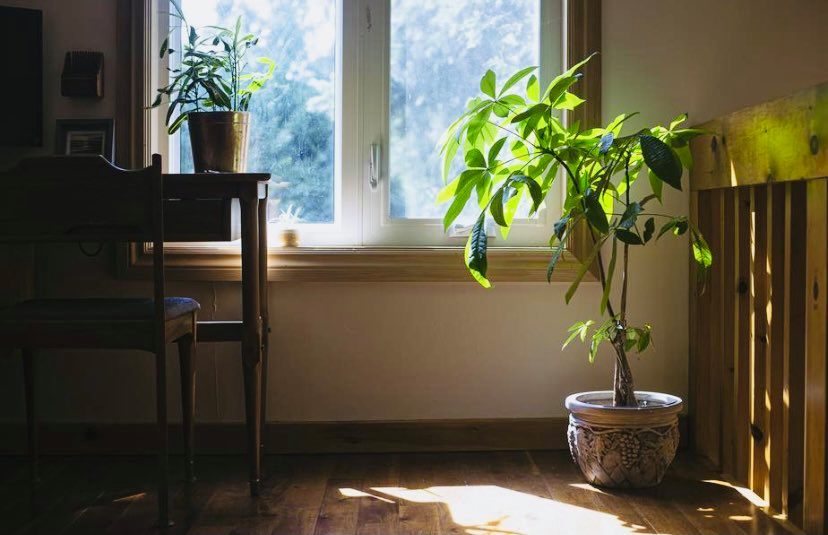
Houseplant Care for Canadian Winters
Share
Most of you know that House of Plants is based in Ottawa, ON. Well, does it ever get chilly here! Canadian winters can be a doozy on our beloved botanical babies. Here are five tips and tricks to get us through the coming season!
Tip 1: Humidity & Temperature
Ottawa experiences the stereotypical Canadian winters. It snows A LOT, and temperatures can drop to minus 40 Celsius (accounting wind-chill). Intuitively, many of us compensate by making our homes extra toasty. Unfortunately, this increased heat will likely dry out houseplants. To keep our plants happy and healthy during winter, we need to be mindful of humidity and temperature. Humidity monitors are an inexpensive way to keep an eye on humidity and temperature. Keep in mind that most common/popular houseplants are tropical, so they will typically thrive in medium to high humidity (40-70 percent) and warm temperatures (14-25 Celcius).
Commercial greenhouses replicate this environment well, but it's often quite muggy, and let's be honest; as much as we adore our plants, most of us would prefer not to feel like we literally live in a greenhouse. To help our plants live their best lives, we want to simulate their "natural" environment.
How to increase humidity:
- Invest in a humidifier. We find this the most effective means of achieving adequate humidity levels. We not only recommend this for plants but for your own comfort as the air tends to get very dry during winters in most indoor spaces.
- Mist Frequently (daily for high-humidity-loving specimens such as calatheas and begonia rex). Please note that you want to mist AROUND the plants/ in the air, NOT directly onto the leaves if you can help it.
- Place humidity-loving plants in the bathroom (if you have a window) think calathea, maranta, ferns, ivy...etc. Cloches or terrariums also work for plants that require high humidity. Still, you must ensure proper aeration, i.e. opening the cloche every few days or using a fan if your plants are in an enclosed cabinet.
- Place plants in or near areas that tend to experience higher humidity, i.e. kitchen, bathroom, and laundry room.
- Group plants with similar requirements to increase humidity-achieved as plants transpire, thereby releasing moisture into the air
- Place potted plants on top of a saucer with pebbles and water. Although the least effective method (from this list) aiding an increase of a mere 1-3 percent, having saucers are beneficial as it helps to protect surfaces from water damage
Tip 2: Don't overfeed –stop fertilizing before winter hits and slow down watering during the winter months
Most houseplants are stagnant in growth or go dormant in the winter. That said, there is little need to continue to feed and hydrate them the same way we were when they were experiencing active growth (late spring & summer). Firstly, stop fertilizing in late summer and by early autumn at the latest. Overfeeding can cause an imbalance of nutrients, compromising its growth and development. If you believe that your plans need a boost, a mild soil enhancer can be an appropriate remedy. We have personally had great experiences with kelp/algae-based products. Apply every 3-4 weeks. Please research whether algae is a beneficial enhancer for the particular plant you're looking to treat. Furthermore, slow down on the watering — water half to one-third less in winter. Overwatering can lead to root rot, and once it gets to this point, it's difficult (not impossible) for the plant to recover.
Tip 3: Don't be afraid to shuffle plants around
This tip can apply all year round. As Canadian plant hobbyists, most of us need to adjust as per seasonal needs. Your plants may have thrived all summer in a particular spot, but now that the temperature has dropped, it may not be ideal for keeping in this spot. All that to say don't be afraid to move plants to accommodate and acclimatize for the colder months. We understand that many plant parents may be reluctant to move their babies if they notice that their plant has been thriving in that particular spot for months. In short, you need to judge the situation. If it's by a heater or near a drafty window, you should probably relocate it for the season. If your beloved plant happens to be in a corner away from a door and heaters and still receives light, it's probably okay if it stays.
Tip 4: Dust off those plants!
Okay, this tip may seem minute, but it can make a difference! A plant's foliage absorbs light, and that's how they photosynthesize, which is how your plants feed themselves. Think of the leaves as windows. Now, imagine how challenging it can be for the sun to get through those dusty panels!
Tip 5: Invest in grow lights
Another apparent struggle for plants in the winter is the decline of sunlight. Yes, there are many wonderful shade-tolerant or lowlight options such as Chinese evergreens, calatheas, begonias, and sansevieria, BUT they still need light. That's the difference between surviving and thriving. Remember, most of our houseplants typically thrive with 6-14hours of sunlight daily. Grow lights are no longer exclusively reserved for commercial operations. They have been much more affordable in the last two decades. They are readily available in home renovation stores and chain stores. You can also order online and can even often find second-hand. In our experience, grow lights are well worth it!
